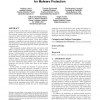872 search results - page 45 / 175 » An Access Control Language for a General Provenance Model |
ASPLOS
2008
ACM
13 years 10 months ago
2008
ACM
Standard concurrency control mechanisms offer a trade-off: Transactional memory approaches maximize concurrency, but suffer high overheads and cost for retrying in the case of act...
CCS
2010
ACM
13 years 9 months ago
2010
ACM
Models based on system calls are a popular and common approach to characterize the run-time behavior of programs. For example, system calls are used by intrusion detection systems...
CDC
2009
IEEE
14 years 1 months ago
2009
IEEE
Abstract— Q-learning is a technique used to compute an optimal policy for a controlled Markov chain based on observations of the system controlled using a non-optimal policy. It ...
SACMAT
2006
ACM
14 years 2 months ago
2006
ACM
Delegation of authority is an important process that needs to be captured by any access control model. In role-based access control models, delegation of authority involves delega...
CSSE
2004
IEEE
13 years 8 months ago
2004
IEEE
Even though the final objective of an access control model is to provide a framework to decide if actions performed by subjects on objects are permitted or not, it is not convenie...

